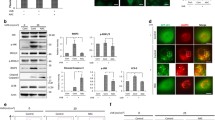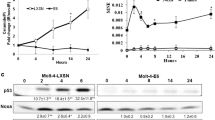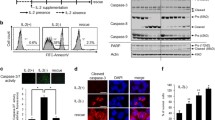Abstract
Ultraviolet light (UV) activates an acid sphingomyelinase (ASMase) pathway, which hydrolyzes sphingomyeline to ceramide. Ceramide has been found to be a second messenger, which activates the c-jun N-terminal kinase (JNK) that is required for apoptotic cell death. However, the role of ceramide in UV-induced JNK activation and apoptosis remains controversial. In this study, we examined the correlation among ceramide production, JNK activation and cell apoptosis after UV-irradiation in three cell lines: 293 (kidney), Jurkat (lymphocytes) and MCF-7 (breast) were used in this study. The ceramide production was analyzed using the diacylglycerol kinase assay method. The JNK activation was measured by Western blot analysis using an antibody specifically recognizing phosphorylated JNK. Cell apoptosis was determined by morphological change or flow cytometry. Our data show that UV-irradiation induces ceramide production in both 293 and Jurkat cells. Inhibition of ceramide production by desipramine (25–50 μM) reduced UV-induced JNK activation in both 293 and Jurkat cells; and protects 293 cells from UV-induced apoptosis. However, inhibition of ceramide production does not prevent Jurkat cells from UV-induced apoptosis. In addition, our data demonstrates that UV-irradiation induces JNK activation and apoptosis of MCF-7 cells without production of detectable amounts of ceramide after UV-irradiation. These results suggest that UV-induced JNK activation and apoptosis can be mediated through a ceramide dependent or an independent pathway.
Similar content being viewed by others
References
Cotton J, Spandau DF: Ultraviolet B-radiation dose influences the induction of apoptosis and p53 in human keratinocytes. Radiat Res 147: 148–155, 1997
Rehemtulla A, Hamilton CA, Chinnaiyan AM, Dixit VM: Ultraviolet radiation-induced apoptosis is mediated by activation of CD-95 (Fas/APO-1). J Biol Chem 272: 25783–25786, 1997
Aragane Y, Kulms D, Metze D, Wilkes G, Poppelmann B, Luger TA, Schwarz T: Ultraviolet light induces apoptosis via direct activation of CD95 (Fas/APO-1) independently of its ligand CD95L. J Cell Biol 140: 171–182, 1998
Kolesnick RN, Haimovitz-Friedman A, Fuks Z: The sphingomyelin signal transduction pathway mediates apoptosis for tumor necrosis factor, Fas, and ionizing radiation. Biochem Cell Biol 72: 471–474, 1994
Kolesnick R, Golde DW: The sphingomyelin pathway in tumor necrosis factor and interleukin-1 signaling. Cell 77: 325–328, 1994
Kolesnick R: Signal transduction through the sphingomyelin pathway. Mol Chem Neuropathol 21: 287–297, 1994
Pena LA, Fuks Z, Kolesnick R: Stress-induced apoptosis and the sphingomyelin pathway. Biochem Pharmacol 53: 615–621, 1997
Obeid LM, Linardic CM, Karolak LA, Hannun YA: Programmed cell death induced by ceramide. Science 259: 1769–1771, 1993
Verheij M, Bose R, Lin XH, Yao B, Jarvis WD, Grant S, Birrer MJ, Szabo E, Zon LI, Kyriakis JM, Haimovitz-Friedman A, Fuks Z, Kolesnick RN: Requirement for ceramide-initiated SAPK/JNK signalling in stressinduced apoptosis. Nature 380: 75–79, 1996
Chen YR, Wang X, Templeton D, Davis RJ, Tan TH: The role of c-Jun N-terminal kinase (JNK) in apoptosis induced by ultraviolet C and gamma radiation. Duration of JNK activation may determine cell death and proliferation. J Biol Chem 271: 31929–31936, 1996
Huang C, Ma W, Ding M, Bowden GT, Dong Z: Direct evidence for an important role of sphingomyelinase in ultraviolet-induced activation of c-Jun N-terminal kinase. J Biol Chem 272: 27753–27757, 1997
Adam D, Ruff A, Strelow A, Wiegmann K, Kronke M: Induction of stress-activated protein kinases/c-Jun N-terminal kinases by the p55 tumour necrosis factor receptor does not require sphingomyelinases. Biochem J 333: 343–350, 1998
Dressler KA, Kolesnick RN: Ceramide 1-phosphate, a novel phospholipid in human leukemia (HL-60) cells. Synthesis via ceramide from sphingomyelin. J Biol Chem 265: 14917–14921, 1990
Hurwitz R, Ferlinz K, Sandhoff K: The tricyclic antidepressant desipramine causes proteolytic degradation of lysosomal sphingomyelinase in human fibroblasts. Biol Chem Hoppe Seyler 375: 447–450, 1994
Basu S, Kolesnick R: Stress signals for apoptosis: ceramide and c-Jun kinase. Oncogene 17: 3277–3285, 1998
Westwick JK, Bielawska AE, Dbaibo G, Hannun YA, Brenner DA: Ceramide activates the stress-activated protein kinases. J Biol Chem 270: 22689–22692, 1995
Ameyar M, Atfi A, Cai Z, Stancou R, Shatrov V, Bettaieb A, Chouaib S: Analysis of human breast adenocarcinoma MCF-7 resistance to tumor necrosis factor-induced cell death. Lack of correlation between JNK activation and ceramide pathway. J Biol Chem 273: 29002–29008, 1998
Yang X, Khosravi-Far R, Chang HY, Baltimore D: Daxx, a novel Fasbinding protein that activates JNK and apoptosis. Cell 89: 1067–1076, 1997
Jayadev S, Liu B, Bielawska AE, Lee JY, Nazaire F, Pushkareva M, Obeid LM, Hannun YA: Role for ceramide in cell cycle arrest. J Biol Chem 270: 2047–2052, 1995
Okazaki T, Bell RM, Hannun YA: Sphingomyelin turnover induced by vitamin D3 in HL-60 cells. Role in cell differentiation. J Biol Chem 264: 19076–19080, 1989
Chatterjee M, Wu S: Fas-receptor and not TNFα-receptor is involved in UV-induced activation of acid sphingomyelinase. Mol Carcinogen (in press)
Author information
Authors and Affiliations
Corresponding author
Rights and permissions
About this article
Cite this article
Chatterjee, M., Wu, S. Cell line dependent involvement of ceramide in ultraviolet light-induced apoptosis. Mol Cell Biochem 219, 21–27 (2001). https://doi.org/10.1023/A:1011083818452
Issue Date:
DOI: https://doi.org/10.1023/A:1011083818452




